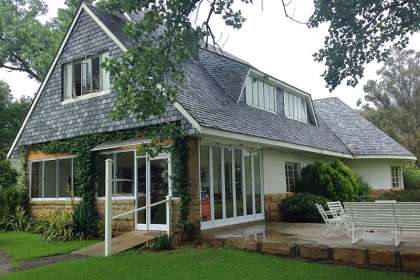Rhodes Trail Run
Rhodes Trail Run
The Rhodes Trail Run was conceived by a small group of property owners in the Victorian era hamlet of Rhodes, in the Eastern Cape, in 1986. The intention of the race, was, to allow the small settlement some recognition, and to prevent it from fading into the background like so may other small rural villages in South Africa.
The first Rhodes Trail Run took place in July 1989, and was almost cancelled due to very heavy snow falls in the region the night before the race. The start of the 2001 event was delayed due, to the fact that officials had to check conditions to establish if seconding vehicles would be able to safely reach the runners. The atmosphere before and after the race is extremely festive. Temperatures at the start of the race regularly range around -10 degrees Celsius.
The entire route stretches over a distance of 52 km, and the initial stage of the event leads participants from the starting point at Rhodes along the Bell River and, into the Kloppers Hoek Valley. The race makes use of a dirt farm road that crosses the Bell River several times via causeways and low-level bridges.
The second stage of the, race is an off-road section approximately eight kilometers from the Lesotho border road Check Point. The route is marked with a series of flags, and follows footpaths and, cattle and sheep trails. This stage ends with a steeply graded ascent up Mavis Bank from the valley, to the Lesotho border Check Point.
The third stage, which covers a, distance of nine kilometers runs along the Lesotho border road, continues through snowfields, and then passes the towering 3,000 mBen MacDhui Mountain. This leg of the race, is also the location of the highest point of the course, which is at 2,677 m at Lesotho View. This stretch is well known for excessive snow, mud and strong head winds. This is the offroad route leading runners from the Tiffindell feeding station to the Hoogenoeg Hikers Huts, via Hoogenoeg Point, and makes up the penultimate stage of the race.This challenging leg of the route features no footpaths, and participants navigate by following the ridge line south to the, next checkpoint. The route is also marked with flags.
Along the final stage of the route the runners perform a steep descent from the mountain plateau into the Carlisles Hoek, Valley, and drop several hundred meters per kilometre. Thereafter the route follows the Carlisles Hoek Valley gravel road back to the finish in Rhodes.
During years which experience heavy snowfall, as in 2002, the route is changed because the feeding station helpers would be unable to reach the plateau, and runners would not be able to make their way through the Mavis, Bank Kloof. A limited field of about 300 runners are allowed entry into the race, and entry is by invitation only with a substitution facility. Those who wish to receive an invitation are required to fill out and submit a waiting list form and will then be placed on the waiting list. The atmosphere both before and after the event is extremely festive, and in the true spirit of trail running, no financial prizes are given. Instead prizes feature numerous floating trophies.
Verblyf Naby Rhodes Trail Run
Woodcliffe Country House
Self Catering House, Cottage, Chalet Accommodation in Maclear
29.5km from Rhodes Trail RunWoodcliffe is a 1000 ha cattle farm extending into the upper slopes of the southern Drakensberg in the north Eastern Cape and is situated 22km from Maclear. Nearby is the remarkable Naude's Nek pass, at 2 620m, the highest mountain pass in South Africa. …sien meer vir besprekings / navrae en inligting.



